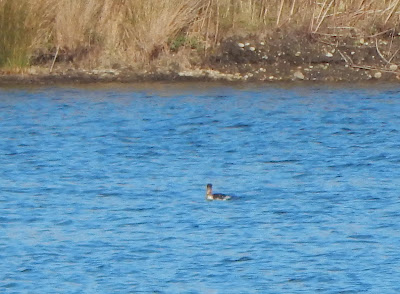 |
| Red Necked Grebe (Podiceps grisegena) at Nosterfield the best shot I could get with my camera. It was a 'grand' Yorkshire day and the water really was that blue! |
 |
| It was at the far side of this lake |
Well as this is a new species I had to do a bit of research and here's what I found:
- The first thing I found out is that it is another Red List species as numbers are declining in summer and winter in the UK.
- It is the rarest of the 5 species of Grebe found in the UK which are Red Necked Grebe, Little Grebe, Great Created Grebe, Slavonian Grebe and Black Necked Grebe.
- There aren't many in the UK, a few (around 20) stay in the summer and might breed. They are joined by a few more in the winter when there are around 55 in the UK.
 |
| One digi-scoped image - it's harder than it looks! |
- Mostly they seem to hang around the south and east coasts so it seems I was really lucky to see one at Nosterfield.
- Globally there are estimated to be over 190,000 and they mainly live and breed in Europe and Asia.
- They are similar sized to Great Crested Grebes, just a little bit smaller with shorter necks.
- They change plumage from summer to winter and this one was starting to change to its summer plumage where it develops its red neck that gives it its name.
- In the UK at least they like to live on ponds, lakes and at the coast.
- To eat they like insects, fish and crustaceans which they dive for and sometimes they bring them to the surface and shake the prey to kill it before eating it.
- They weigh between 0.8kg - 1.6kg and are around 43-56cm long.
 |
| And a second - have to get the focus sorted! |
- When breeding both male and female help to build a nest of floating vegetation anchored to some aquatic vegetation. Both parents also help with incubation of the eggs.
- One of my favourite Grebe facts is about their young - this one and the Great Crested Grebe at least - once the young hatch they climb on the parent's back and are carried around until they get too big. I've seen photos of this but not yet seen that in the wild - I will be on the look out this Spring so I can hopefully get a picture!
Hope you enjoyed,
Z.
Great finds Zach! - Tasha
ReplyDelete